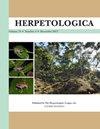Ecological Niche Explains the Sympatric Occurrence of Lined Ground Snakes of the Genus Lygophis (Serpentes, Dipsadidae) in the South American Dry Diagonal
IF 1.1
3区 生物学
Q2 ZOOLOGY
引用次数: 1
Abstract
Abstract The geographic distribution of a species is limited by many factors, including its ecological and evolutionary history. Species distribution modeling has been used to evaluate the effects of climate and other variables on geographic distribution and to measure the degree of niche similarity among co-occurring species. Our goal in this study was to compare the geographic distributions and ecological niches of four closely related species of lined ground snakes, Lygophis dilepis, L. flavifrenatus, L. meridionalis, and L. paucidens. These species are distributed along the South American Dry Diagonal. We found that the four species of Lygophis overlap somewhat along their distributions with a low degree of niche overlap. Lygophis dilepis shows a disjunct distribution with two isolated populations. The break in the distribution of L. dilepis in Central Brazil is filled by L. meridionalis, which is found mostly in the highlands of the Central Plateau. Because of the disjunct distribution of L. dilepis, we performed species distribution modeling on both populations separately. The environmental niches of the two populations of L. dilepis were indistinguishable according to the niche equivalence tests, but the distribution of one of these populations did not predict the distribution of the second one, and vice versa. Our study shows that niche partitioning may allow for the coexistence of Lygophis species.生态位解释了南美洲干对角线上Lygophis属(蛇科,Dipsadidae)的衬里地蛇的同域发生
摘要一个物种的地理分布受到许多因素的限制,包括其生态和进化史。物种分布模型已被用于评估气候和其他变量对地理分布的影响,并测量共存物种之间的生态位相似程度。我们在这项研究中的目标是比较四种亲缘关系密切的地蛇的地理分布和生态位,这四种地蛇是地鼠、黄耳草、子午草和少食草。这些物种分布在南美洲的干对角线上。我们发现,四种地鼠在分布上有一定的重叠,生态位重叠程度较低。Lygophis dilopis表现出两个孤立种群的间断分布。在巴西中部,L.dilopis分布的断裂被主要分布在中央高原高地的L.meridionalis所填补。由于L.dilipis的间断分布,我们分别对两个种群进行了物种分布建模。根据生态位等效性测试,两个群体的环境生态位是不可区分的,但其中一个群体的分布不能预测第二个种群的分布,反之亦然。我们的研究表明,生态位划分可能允许Lygophis物种共存。
本文章由计算机程序翻译,如有差异,请以英文原文为准。
求助全文
约1分钟内获得全文
求助全文
来源期刊

Herpetologica
生物-动物学
CiteScore
4.60
自引率
0.00%
发文量
27
审稿时长
>12 weeks
期刊介绍:
Established in 1936, Herpetologica is a quarterly peer-reviewed journal serving herpetologists, biologists, ecologists, conservationists, researchers and the scientific community. The journal contains original research papers and essays about the biology of reptiles and amphibians, and covers many relevant topics including: behavior, conservation, ecology, genetics, morphology, physiology and taxonomy.
 求助内容:
求助内容: 应助结果提醒方式:
应助结果提醒方式:


